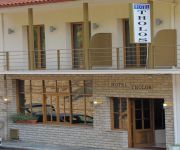Facts and Data
Webpages:
Official Unesco Page
View photos from OUR PLACE the World Heritage collection
Hellenic Ministry of Culture
Basis Data:
Unesco World heritage since: 1987
Size of heritage: 51 ha
- Buffer zone: 14,314 ha
Coordinates:
Longitude: 22,496°
Latitude: 38,481°
Summary
The pan-Hellenic sanctuary of Delphi, where the oracle of Apollo spoke, was the site of the omphalos, the 'navel of the world'. Blending harmoniously with the superb landscape and charged with sacred meaning, Delphi in the 6th century B.C. was indeed the religious centre and symbol of unity of the ancient Greek world.
Location on Map
Show bigger map on Openstreetmap
Archaeological Site of Delphi
The Archaeological Site of Delphi, located in the Prefecture of Phokis in the Region of Central Greece, is a UNESCO World Heritage site of immense historical and cultural significance. Nestled on the slopes of Mount Parnassus, this ancient sanctuary was dedicated to the god Apollo and served as the center of the world in Greek mythology.
History
The history of Delphi dates back to the 8th century BCE when it became a religious and cultural hub for the ancient Greeks. According to legend, Zeus released two eagles from opposite ends of the world, and they met at Delphi, marking it as the navel of the earth. Delphi soon became renowned as the site of the Oracle of Delphi, where the Pythia, a priestess, would deliver prophecies from Apollo.
Throughout the centuries, Delphi grew in importance and wealth, attracting pilgrims from all over Greece and beyond. The site was adorned with magnificent temples, treasuries, and statues, many of which were gifts from grateful city-states. The most famous structure at Delphi is the Temple of Apollo, which housed the Oracle and was considered the center of the universe.
Delphi's influence extended beyond religious and cultural realms. It played a crucial role in political affairs, as city-states sought the Oracle's guidance before making important decisions. Delphi also hosted the Pythian Games, a prestigious athletic and artistic competition held every four years, similar to the Olympic Games.
Current State
Today, the Archaeological Site of Delphi stands as a testament to the grandeur of ancient Greece. Visitors can explore the ruins and marvel at the remnants of its once-magnificent structures. The site is divided into several areas, each offering a unique glimpse into Delphi's past.
The Sanctuary of Apollo, with its imposing Temple of Apollo, is the heart of the site. Although the temple is now in ruins, its Doric columns and foundations provide a glimpse into its former glory. Nearby, the Theater of Delphi, built into the hillside, once hosted performances and gatherings.
The Delphi Museum, located on-site, houses a remarkable collection of artifacts discovered during excavations. Among the most famous exhibits is the Charioteer of Delphi, a bronze statue that is considered one of the finest examples of ancient Greek sculpture.
Visitors can also explore the Stadium, where the Pythian Games were held, and the Gymnasium, where athletes trained. The Tholos, a circular building with intricate architecture, is another highlight of the site.
The Archaeological Site of Delphi continues to be a place of pilgrimage for those seeking to connect with Greece's ancient past. Its historical and cultural significance, combined with its breathtaking natural surroundings, make it a must-visit destination for history enthusiasts and travelers alike.
Preservation efforts are ongoing to protect and maintain the site's fragile structures and artifacts. The Greek government, in collaboration with UNESCO, ensures that the Archaeological Site of Delphi remains accessible to future generations, allowing them to appreciate the rich heritage of this remarkable World Heritage site.
Hotels and places to stay
Amalia Hotel Delphi
Phaethon
Parnassos
Art Pythia Hotel
Olympic Hotel
Pitho
Varonos
Tholos
Aiolos Hotel
Castri
Videos from the area
Videos provided by Youtube are under the copyright of their owners.
















